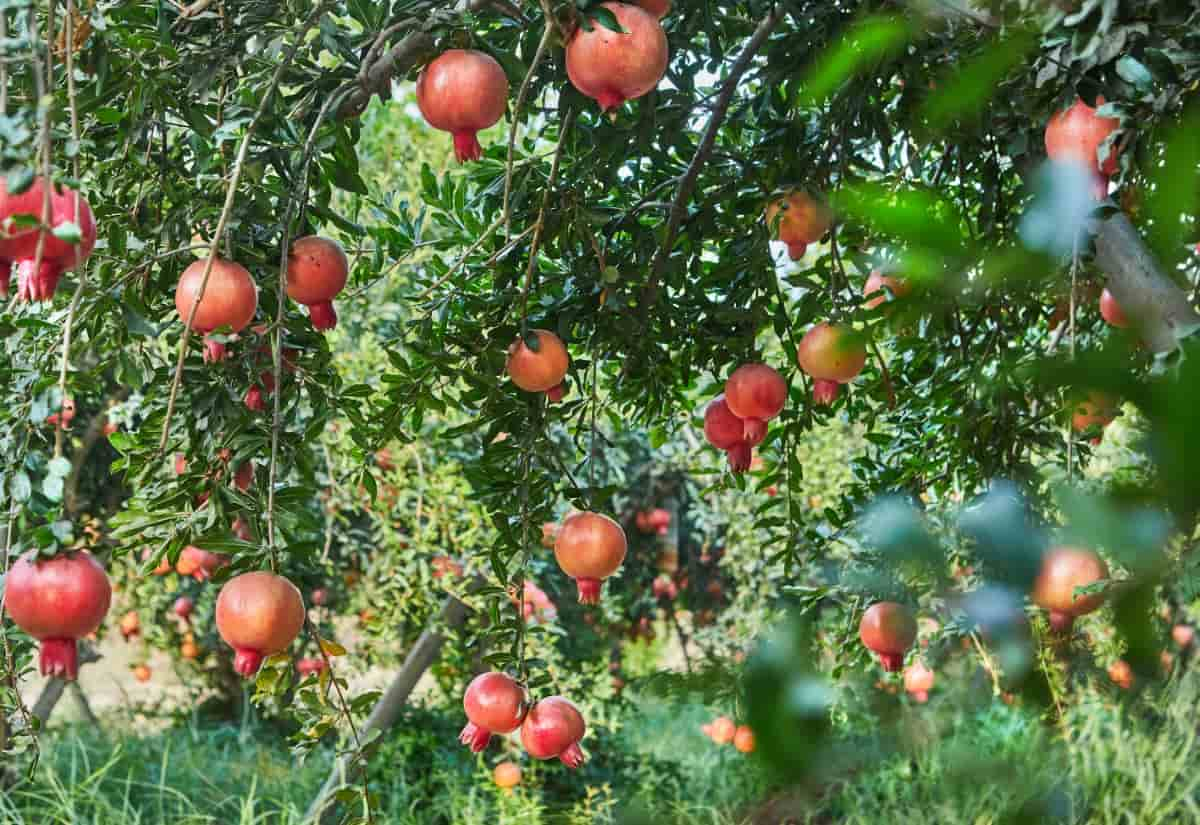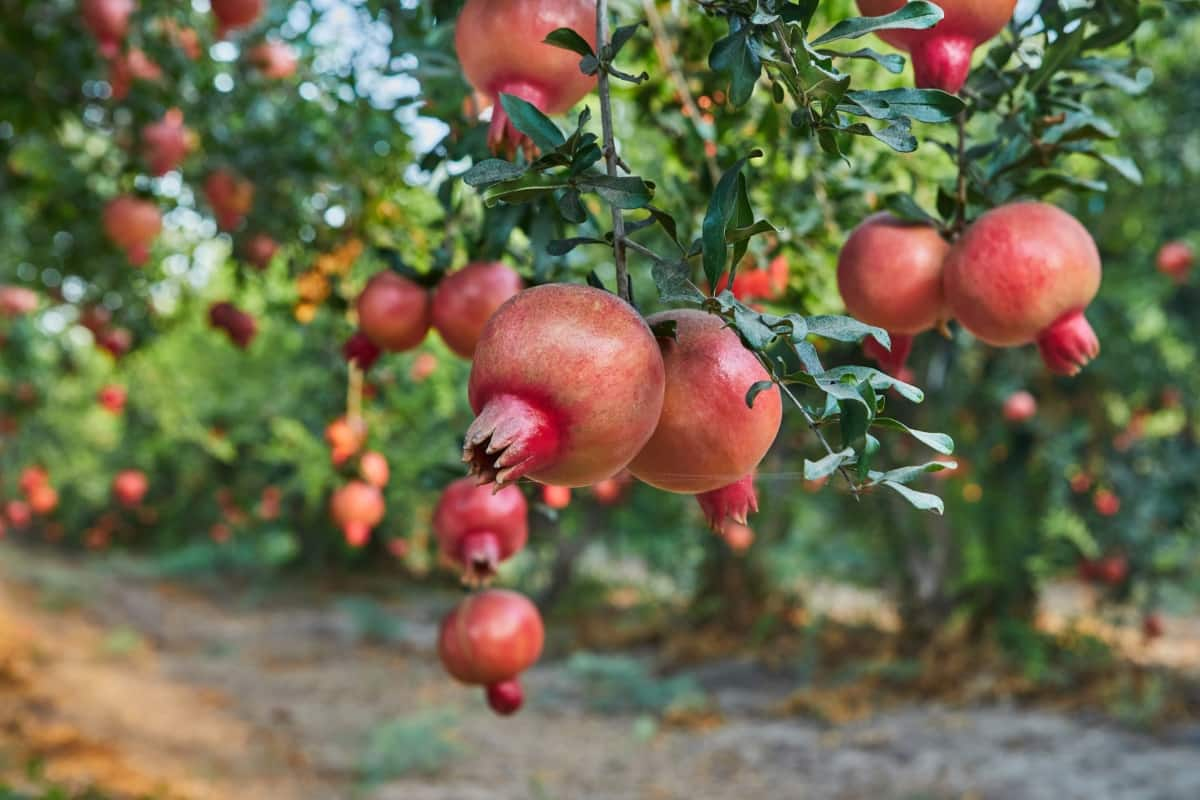The initial investment for drip irrigation in a pomegranate plantation typically ranges from 1.2 to 1.6 lakh rupees per acre. This includes the cost of drip tubing, emitters, filters, pumps, and installation expenses. Factors such as the size of the plantation, soil type, and water source can influence the overall cost. While the initial investment may seem substantial, drip irrigation offers efficient water use, reduced labor, and improved crop yield, making it a cost-effective and sustainable choice for pomegranate cultivation in the long run.

Evaluate the Cost of Drip Lines and Emitters for Pomegranate Fields
Drip lines are the pipelines that transport water from the main supply to the plants. These can be of different materials and thicknesses, affecting their cost. High-quality drip lines are crucial for durability and uniform water distribution. On average, the cost of drip lines can range from Rs. 15,000 to Rs. 20,000 per acre, depending on the chosen specifications.
Emitters, the devices responsible for releasing water directly to the plants, also contribute to the overall cost. The type of emitter, such as inline or online emitters, and their flow rate influence the cost. The price of emitters can vary from Rs. 10,000 to Rs. 15,000 per acre.
Analyze the Expense of Filters and Pressure Regulators
Filters play a vital role in preventing clogging of emitters and drip lines by removing particles and debris from the water. The cost of filters can vary based on their type, such as screen or disc filters, and their capacity. On average, the expense of filters in a drip irrigation system for pomegranate farming can range from Rs. 8,000 to Rs. 15,000 per acre.
Pressure regulators are essential for maintaining uniform water distribution and preventing damage to the drip system components. The cost of pressure regulators depends on their quality, type, and capacity to handle specific water pressure requirements. Generally, the expense of pressure regulators can range from Rs. 5,000 to Rs. 10,000 per acre.
Estimate the Cost of Automation and Control Systems
Automation systems include controllers, sensors, and software that allow farmers to schedule irrigation, monitor soil moisture levels, and adjust water delivery based on plant needs. The cost of automation systems can vary depending on the level of sophistication and the number of features. On average, the expense of automation systems for drip irrigation in pomegranate orchards ranges from Rs. 20,000 to Rs. 40,000 per acre.
In case you missed it: Cost of Drip Irrigation Per Acre for Dragon Fruit: Exploring Installation Costs Along with Subsidy

While the upfront cost of automation systems may seem significant, the long-term benefits, such as water conservation, energy savings, and improved crop yields, often justify the investment. Farmers should consider factors like the size of the plantation, weather conditions, and their technical expertise when deciding on the level of automation.
Assess the Price of Pumps and Pumping Stations
The cost of pumps depends on factors such as capacity, type (centrifugal or submersible), and energy efficiency. On average, the expense of pumps for drip irrigation in pomegranate orchards can range from Rs. 30,000 to Rs. 40,000 per acre. It’s crucial to select a pump that aligns with the water requirements of the orchard and ensures consistent water delivery to the drip system.
Explore the Cost of Fertilizer and Nutrient Injection Systems
Exploring the cost of these systems provides valuable insights into the investment required for precision nutrient management. Fertilizer and nutrient injection systems typically include injection pumps, tanks, and controllers. The cost can vary based on the type and capacity of the injection system. On average, the expense of fertilizer and nutrient injection systems for drip irrigation in pomegranate orchards ranges from Rs. 15,000 to Rs. 25,000 per acre. The benefits of these systems include improved nutrient utilization, reduced wastage, and enhanced crop performance.
Calculate the Labor and Installation Costs
Calculating these costs provides farmers with a clear picture of the financial implications associated with the installation and setup of the drip irrigation system. Labor costs encompass the wages paid to skilled workers involved in the installation process. This includes tasks such as trenching, laying pipes, installing emitters, and connecting the entire drip irrigation system. On average, labor costs for drip irrigation installation in pomegranate plantations can range from Rs. 20,000 to Rs. 25,000 per acre.
Factor the Maintenance and Repair Expenses
Maintenance costs involve regular tasks such as cleaning filters, inspecting emitters, and checking for leaks. Farmers should allocate an annual budget for maintenance, typically ranging from Rs. 5,000 to Rs. 10,000 per acre. Routine maintenance helps prevent issues that could affect the system’s efficiency and the health of pomegranate crops.
In case you missed it: Cost of Drip Irrigation Per Acre for Mango Plantation: Exploring Installation Costs Along with Subsidy

Repair expenses may be incurred for unexpected issues, such as damaged pipes, faulty emitters, or other system components. The annual repair costs can vary based on the extent of the damage, with an average range of Rs. 5,000 to Rs. 10,000 per acre. Timely repairs are crucial to minimizing downtime and avoiding potential losses in crop yield.
Energy Costs Associated with Drip Irrigation in Pomegranate Cultivation
The primary sources of energy consumption in drip irrigation include pumps that supply water to the system. The energy costs associated with pumps can vary based on factors such as pump capacity, duration of operation, and local electricity rates. On average, energy costs for drip irrigation in pomegranate cultivation can range from Rs. 10,000 to Rs. 12,000 per acre annually.
Farmers can implement energy-efficient practices, such as optimizing pump schedules and using energy-efficient pump models, to reduce energy consumption. Also, exploring alternative energy sources, such as solar-powered pumps, may provide long-term cost-saving benefits.
Cost of Drip Irrigation Per Acre for Pomegranate Plantation
| Item | Cost Range (INR) |
| Drip Lines & Emitters | 25,000-35,000 |
| Filters and Pressure Regulators | 13,000-25,000 |
| Automation and Control Systems | 20,000-40,000 |
| Pumps and Pumping Stations | 30,000-40,000 |
| Fertilizer and Nutrient Injection Systems | 15,000-25,000 |
| Labor and Installation Costs | 20,000-25,000 |
| Maintenance and Repair Expenses | 10,000-20,000 |
| Energy Costs | 10,000-15,000 |
Government Subsidy for Pomegranate Drip Irrigation
Government subsidies play a crucial role in facilitating the adoption of drip irrigation in pomegranate farming. These are designed to ease the financial burden on farmers and promote water-efficient and sustainable irrigation practices. Subsidies for drip irrigation systems often cover a percentage of the overall installation costs, including components such as pipes, emitters, filters, and controllers.
Pradhan Mantri Krishi Sinchayee Yojana (PMKSY) has launched with the main motto of providing “Har Khet Ko Paani” and end-to-end solutions in the irrigation supply chain. The financial assistance payable to the beneficiary under the micro irrigation scheme will be 55% for small and marginal farmers, whereas it will be 45% for other farmers.
Compare the Overall Operational Costs of Drip Irrigation vs. Traditional Methods in Pomegranate Farming
Drip irrigation offers advantages such as water efficiency, targeted nutrient delivery, and potential increases in crop yields. While the initial investment in drip irrigation systems may be higher, the operational costs over time can be more manageable. The maintenance of drip systems is generally less labor-intensive compared to traditional methods, contributing to cost savings.
Traditional irrigation methods, such as flood or furrow irrigation, may have lower initial costs but can result in higher water consumption, increased labor requirements, and potentially lower crop yields due to uneven water distribution. Farmers should consider factors such as water availability, labor costs, and crop requirements when evaluating the overall operational costs.
In case you missed it: Cost of Drip Irrigation Per Acre for Apple Plantation: Exploring Installation Costs Along with Subsidy

Conclusion
Adopting drip irrigation for pomegranate plantations involves an initial investment covering components like filters, emitters, and automation systems. Installation costs, though significant, can be offset by government subsidies. Considering the long-term benefits of reduced water usage and increased crop yields, the overall cost-effectiveness and sustainability of drip irrigation make it a prudent choice.
- Feed Your Flock for Less: Top 10 Tips to Save on Chicken Feed
- Ultimate Guide to Ossabaw Island Hog: Breeding, Raising, Diet, and Care
- Hatching Answers: The Top 10 Reasons Your Chickens Aren’t Laying Eggs
- Eggs and Economics: Breaking Down the Cost of Raising Backyard Chickens
- Defend Your Greens: Proven Methods to Keep Iguanas Out of Your Garden
- Ultimate Guide to Cinnamon Queen Chicken: A Comprehensive Guide for Beginners
- Ultimate Guide to California Tan Chicken: Breeding, Raising, Diet, Egg-Production and Care
- Ultimate Guide to Marsh Daisy Chicken: Breeding, Raising, Diet, and Care
- 10 Types of Chicken Farming Businesses You Can Start for Profits